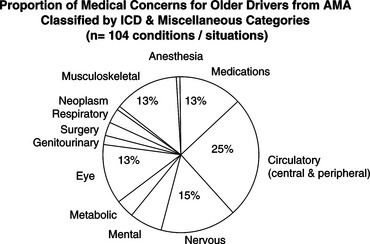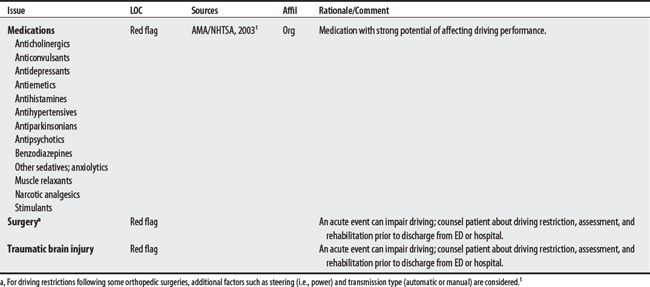Chapter 20 Older Drivers with Acute or Chronic Medical Conditions (Includes Noncommercial Motor Vehicles, Excludes Commercial Drivers)
The primary guideline for assessing and counseling older drivers is set forth by the American Medical Association (AMA)1 in conjunction with the National Highway Traffic Safety Administration (NHTSA). Older drivers are at greater risk for fatal crashes because of their fragility. Three important areas that tend to decline in function in older drivers are (1) vision, (2) cognition, and (3) motor function.2
Red flags (listed below) indicate a medical condition in need of further evaluation or management. These concerns may be observed from patient behavior, witnessed during acute events, or noted in a patient’s medical history.1 The complete list of medical concerns with detailed explanations can be found at the AMA web site (http://www.ama-assn.org/ama/pub/category/1079.html).
RED FLAGS AND CONTRAINDICATIONS FOR DRIVING
E00-E90 ENDOCRINE, NUTRITIONAL, AND METABOLIC DISEASES
F00-F99 MENTAL AND BEHAVIORAL DISORDERS
G00-G99 DISEASES OF THE NERVOUS SYSTEM
H60-H95 DISEASES OF THE EAR AND MASTOID PROCESS
I00-I99 DISEASES OF THE CIRCULATORY SYSTEM
J00-J99 DISEASES OF THE RESPIRATORY SYSTEM
M00-M99 DISEASES OF THE MUSCULOSKELETAL SYSTEM AND CONNECTIVE TISSUE
N00-N99 DISEASES OF THE GENITOURINARY SYSTEM
S00-T98 INJURY, POISONING, AND CERTAIN OTHER CONSEQUENCES OF EXTERNAL CAUSES
PROCEDURAL CONCERNS
TIPS ON PREVENTING A PERSON WITH ALZHEIMER’S FROM DRIVING
| Tip | Source | Affil |
|---|---|---|
| Ask a doctor to write a “do not drive” prescription | AA 6 | Org |
| Control access to car keys | ||
| Disable the car by removing the battery or distributor cap | ||
| Park the car in a neighbor’s driveway or on another block | ||
| Substitute a license with a photo ID and make car inaccessible |
1 American Medical Association. Physician’s guide to assessing and counseling older drivers [2003]. Available at: http://www.ama-assn.org/ama/pub/category/10791.html. Accessed November 7, 2005
2 American Medical Association. Why are older drivers at risk? Available at: http://www.ama-assn.org/ama/pub/category/9115.html. Accessed November 7, 2005
3 Kakaiya R, Tisovec R, Fulkerson P. Evaluation of fitness to drive: The physician’s role in assessing elderly or demented patients. Postgrad Med. 2000;107(3):229-236.
4 Tan JC. Practical manual of physical medicine and rehabilitation: diagnostics, therapeutics, and basic problems. St Louis: Mosby, 1998.
5 Association for Driver Rehabilitation Specialists. Home page. Available at: http://www.driver-ed.org. Accessed November 7, 2005
6 Alzheimer’s Association (AA). Home page. Available at http://search.alz.org/. Accessed November 7, 2005
7 American Geriatric Society. The patient education forum: safe driving for seniors. Available at: http://www.americangeriatrics.org. Accessed November 7, 2005


























